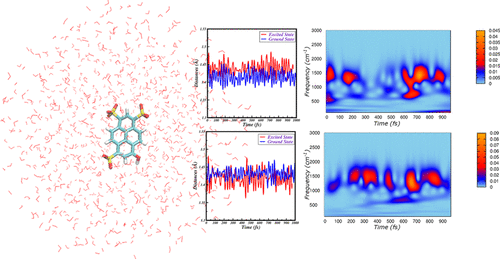当前位置:
X-MOL 学术
›
J. Phys. Chem. A
›
论文详情
Our official English website, www.x-mol.net, welcomes your feedback! (Note: you will need to create a separate account there.)
Exploring Nuclear Photorelaxation of Pyranine in Aqueous Solution: an Integrated Ab-Initio Molecular Dynamics and Time Resolved Vibrational Analysis Approach
The Journal of Physical Chemistry A ( IF 2.9 ) Pub Date : 2018-02-21 00:00:00 , DOI: 10.1021/acs.jpca.7b12371 Maria Gabriella Chiariello 1 , Nadia Rega 1, 2
The Journal of Physical Chemistry A ( IF 2.9 ) Pub Date : 2018-02-21 00:00:00 , DOI: 10.1021/acs.jpca.7b12371 Maria Gabriella Chiariello 1 , Nadia Rega 1, 2
Affiliation

|
Advances in time-resolved vibrational spectroscopy techniques provided a new stimulus for understanding the transient molecular dynamics triggered by the electronic excitation. The detailed interpretation of such time-dependent spectroscopic signals is a challenging task from both experimental and theoretical points of view. We simulated and analyzed the transient photorelaxation of the pyranine photoacid in aqueous solution, with special focus on structural parameters and low frequency skeleton modes that are possibly preparatory for the photoreaction occurring at later time, as suggested by experimental spectroscopic studies. To this aim, we adopted an accurate computational protocol that combines excited state ab initio molecular dynamics within an hybrid quantum mechanical/molecular mechanics framework and a time-resolved vibrational analysis based on the Wavelet transform. According to our results, the main nuclear relaxation on the excited potential energy surface is completed in about 500 fs, in agreement with experimental data. The rearrangement of C–C bonds occurs according to a complex vibrational dynamics, showing oscillatory patterns that are out of phase and modulated by modes below 200 cm–1. We also analyzed in both the ground and the excited state the evolution of some structural parameters involved in excited state proton transfer reaction, namely, those involving the pyranine and the water molecule hydrogen bonded to the phenolic O–H group. Both the hydrogen bond distance and the intermolecular orientation are optimized in the excited state, resulting in a tighter proton donor–acceptor couple. Indeed, we found evidence that collective low frequency skeleton modes, such as the out of plane wagging at 108 cm–1 and the deformation at 280 cm–1, are photoactivated by the ultrafast part of the relaxation and modulate the pyranine–water molecule rearrangement, favoring the preparatory step for the photoreactivity.
中文翻译:

探索吡喃在水溶液中的核光弛豫:一种集成的从头算分子动力学和时间分辨振动分析方法
时间分辨振动光谱技术的进步为理解由电子激发触发的瞬态分子动力学提供了新的动力。从实验和理论的角度来看,这种与时间有关的光谱信号的详细解释都是一项艰巨的任务。我们模拟并分析了吡喃光酸在水溶液中的瞬时光松弛,并特别关注结构参数和低频骨架模式,这可能是为以后发生的光反应做准备,这是由实验光谱研究建议的。为了这个目的,我们采用了一种精确的计算协议,该协议将混合态量子力学/分子力学框架内的激发态从头算分子动力学与基于小波变换的时间分辨振动分析相结合。根据我们的结果,与实验数据一致,在激发势能表面上的主要核弛豫大约在500 fs内完成。C–C键的重排是根据复杂的振动动力学进行的,显示出异相的振荡模式,并受到200 cm以下模式的调制–1。我们还分析了在基态和激发态下与激发态质子转移反应有关的一些结构参数的演化,即涉及吡喃和水分子与氢键合到酚基OH基团上的氢。氢键的距离和分子间的取向都在激发态下进行了优化,从而导致了更紧密的质子供体-受体对。确实,我们发现有证据表明,集体的低频骨架模式,例如在108 cm –1处的平面外摆动和在280 cm –1处的变形,被弛豫的超快部分光激活,并调节吡喃-水分子的重排,有利于光反应性的准备步骤。
更新日期:2018-02-21
中文翻译:

探索吡喃在水溶液中的核光弛豫:一种集成的从头算分子动力学和时间分辨振动分析方法
时间分辨振动光谱技术的进步为理解由电子激发触发的瞬态分子动力学提供了新的动力。从实验和理论的角度来看,这种与时间有关的光谱信号的详细解释都是一项艰巨的任务。我们模拟并分析了吡喃光酸在水溶液中的瞬时光松弛,并特别关注结构参数和低频骨架模式,这可能是为以后发生的光反应做准备,这是由实验光谱研究建议的。为了这个目的,我们采用了一种精确的计算协议,该协议将混合态量子力学/分子力学框架内的激发态从头算分子动力学与基于小波变换的时间分辨振动分析相结合。根据我们的结果,与实验数据一致,在激发势能表面上的主要核弛豫大约在500 fs内完成。C–C键的重排是根据复杂的振动动力学进行的,显示出异相的振荡模式,并受到200 cm以下模式的调制–1。我们还分析了在基态和激发态下与激发态质子转移反应有关的一些结构参数的演化,即涉及吡喃和水分子与氢键合到酚基OH基团上的氢。氢键的距离和分子间的取向都在激发态下进行了优化,从而导致了更紧密的质子供体-受体对。确实,我们发现有证据表明,集体的低频骨架模式,例如在108 cm –1处的平面外摆动和在280 cm –1处的变形,被弛豫的超快部分光激活,并调节吡喃-水分子的重排,有利于光反应性的准备步骤。



























 京公网安备 11010802027423号
京公网安备 11010802027423号